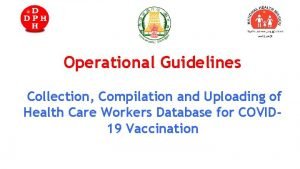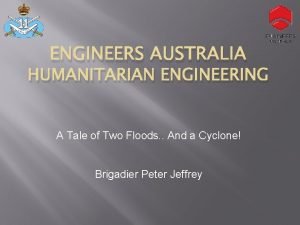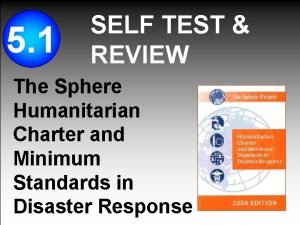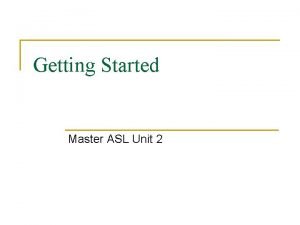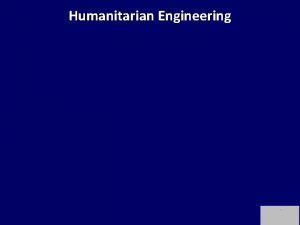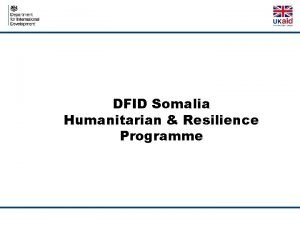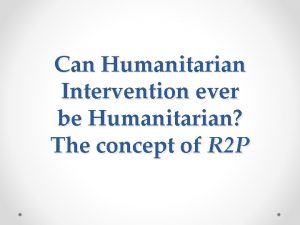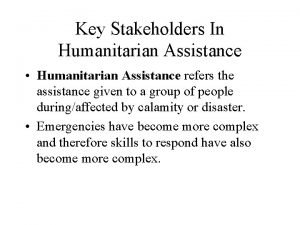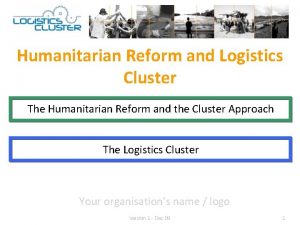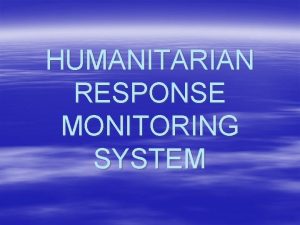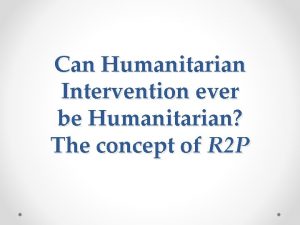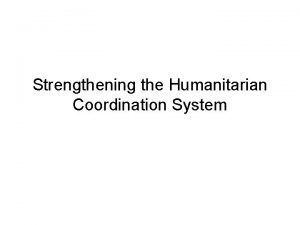Humanitarian Engineering Creating Technologies That Help People Prof

































- Slides: 33

Humanitarian Engineering: Creating Technologies That Help People Prof. Kevin M Passino https: //osuhe. engineering. osu. edu

Outline: • Humanitarian technologies • Humanitarian engineering • University activities Focus is on development, not, e. g. , natural disasters 2

Humanitarian Technology: Water: Delivery (pipes and pumps), filtration (chemical, solar, mechanical, thermal, etc. ) 3

Sanitation: For human waste, grey water, trash, etc. Transport/piping away from source Avoid contamination (e. g. , of drinking water) 4

Agriculture: Irigation: Fertilizer, seeds, soil, equipment, etc. 5

Energy: Solar, wind, hydro, etc. Use: Cookstoves, lighting, work, etc. 6

Shelter: Durable, weather-resistant, inexpensive, etc. 7

Information technology: Low-cost computers, cell phones, etc. 8

Health, education: Diagnostic equipment, medicines, etc. Computer technology for education, handson STEM education projects 9

Important role for engineers in development? Underlying challenges are often technological and demand engineering and social skills! What can engineers do to help? How to do it? 10

The 10 Principles of Humanitarian Engineering An overview of the key ideas… 11

1. Focus on People • Individuals are unique and infinitely valuable, talk/respect/solidarity • Suffering, compassion https: //commons. wikimedia. org/ wiki/Fil: Homeless_Man. jpg 12

2. Relate, Listen, Ask, Cooperate, Empower • Build relationships, trust, community participation, inclusiveness, multidisciplinary teams, and cooperation • Needs/assets/desires assessment, active listening • Empower people https: //www. flickr. com/photos/ theworldfishcenter/26627012643 13

3. Understand Social and Physical Context • People, communities, culture, history • Built and natural environment, resources, institutions https: //en. wikipedia. org/ wiki/Culture 14

4. Be a Professional Humanitarian Engineer • Competence and conduct • Create the best design that meets all constraints (performance, reliability, cost, environmental, social, etc. ) in context and keeping the people firmly in mind 15

5. Build Technological Capacity • Empower the community to create its own solutions • STEM education empowers students https: //en. wikipedia. org/ wiki/Education 16

6. Ensure Long-Term Positive Impact • Design for reliability in extreme conditions • Build technological capacity for operation and maintenance 17

7. Understand Impact on/from Social Context • People, power relations • Education, health, economic development https: //pixabay. com/en/circle-community-hands-holding-159252/ 18

8. Design for Sustainability • Resource use and pollution impacts • Life-cycle design and design for environment NASA 19

9. Assess Outcomes • Deployed technology effectiveness, sideeffects • Basis for later improvement or scale-up 20

https: //www. flickr. com/photos/ punktoad/5540843967 10. Promote Human Dignity, Rights, and Fulfillment • Focus on human development, ideas from social justice • Reduction of inequalities in technological capacity, and promotion of inclusiveness https: //www. flickr. com/photos/ neverendingalbum/8442395301 21

• For more information… • Textbook, Edition 3 • Free download Also mathematical and computational material, research challenges https: //hebook. engineering. osu. edu 22

Humanitarian Engineering Center The Ohio State University College of Engineering https: //osuhe. engineering. osu. edu 23

Partners and Sponsors All engineering disciplines Social work International development Health, Education Business Global Water Initiative One Health Initiative (Ethiopia) Agricultural sciences NGOs, universities 24

Humanitarian Engineering Center 25

Global Engineering Fieldwork International Projects: Water supply and filtration, sanitation, energy (solar, wind), lighting, agriculture (irrigation, aquaponics), cookstoves, shelter, computer/IT, STEM education for disadvantaged schools and universities Needs-driven advanced research 26

Columbus, Ohio T 4 C US Projects: Homeless. Heating, cooking, shelter, food pantries-logistics, computers, wheelchair ramps 27

Always work with an in-country partner: • Nongovernmental Organization (NGO) • Hand-in-hand direct work on projects —they know the community (needs) best • Technological consultant to NGO (e. g. , what technology to purchase? , how to deploy? ) • Universities, professional organizations (e. g. , IEEE) 28 • Alumni

Humanitarian Engineering Courses • ENGR 5050 Humanitarian Engineering (Sp 14, 29; Sp 15, 50; Sp 16, 66; Sp 17, 67), online, https: //hecourse. engineering. osu. edu • ECE 5194. 06 Computational Humanitarianism (Au 14, 12; Sp 17, 19) • ENGR 5194 Appropriate Technology for Developing Countries (Sp 16, 25) • Civ. Eng Sustainable Community Development (planned, Au 17) All are graduate/undergraduate courses 29

Course Preparation for Projects / Trips ENGR 4962. XXS: Service-Learning in Eng. Honduras, Montaña de Luz Honduras, Choluteca Guatemala India, Tanzania Ghana, El Salvador Haiti, Dominican Republic Colombia Graduate or undergraduate Minor: - Core courses - “Human Welfare” - Project >320 students since 2005 Capstone design (Co. E, Dept) Research, Independent Study, Honor Theses, Study Abroad 30

Student organizations 1. Engineers for Community Service (ECOS) 2. Engineers Without Border (EWB) 3. Engineer for a Sustainable World (ESW) 4. Solar Education and Outreach (SEO) 5. SERVitecture 6. Design Building Institute of America, OSU 7. Ecological Engineering Society of OSU 31 8. Design Outreach Student Club

Graduate Programs / Research • 10 faculty in Co. E supervising MS/Ph. D • External funding, $6. 3 M current • Broad collaborations • MS program in development (likely, Graduate Interdisciplinary Specialization) • Ph. D program: One-of-a-kind Ph. D 32

Summary: • Engineers helping the poor via technology • Provides challenging real-world engineering design problems • Design problems that “really matter” • Easily fits in engineering curriculum (for all majors), e. g. , capstone design • Provides new research challenges 33
 Phân độ lown ngoại tâm thu
Phân độ lown ngoại tâm thu Block nhĩ thất độ 1
Block nhĩ thất độ 1 Thể thơ truyền thống
Thể thơ truyền thống Thơ thất ngôn tứ tuyệt đường luật
Thơ thất ngôn tứ tuyệt đường luật Chiến lược kinh doanh quốc tế của walmart
Chiến lược kinh doanh quốc tế của walmart Tìm độ lớn thật của tam giác abc
Tìm độ lớn thật của tam giác abc Hãy nói thật ít để làm được nhiều
Hãy nói thật ít để làm được nhiều Tôn thất thuyết là ai
Tôn thất thuyết là ai Gây tê cơ vuông thắt lưng
Gây tê cơ vuông thắt lưng Sau thất bại ở hồ điển triệt
Sau thất bại ở hồ điển triệt Ee.humanitarian response.info/x/vpdlixjf
Ee.humanitarian response.info/x/vpdlixjf Humanitarian work psychology
Humanitarian work psychology Humanitarian projects in prague for youth
Humanitarian projects in prague for youth Wcag
Wcag Humanitarian programme cycle
Humanitarian programme cycle Cadet humanitarian award
Cadet humanitarian award Cadet humanitarian award
Cadet humanitarian award Humanitarian engineers in cape york
Humanitarian engineers in cape york International humanitarian law icrc
International humanitarian law icrc International humanitarian law icrc
International humanitarian law icrc Ihl
Ihl Khalifa humanitarian foundation
Khalifa humanitarian foundation Domistan
Domistan Humanitarian work psychology
Humanitarian work psychology The american people creating a nation and a society
The american people creating a nation and a society Freesurfer troubleshooting
Freesurfer troubleshooting Help help i'm being oppressed
Help help i'm being oppressed Becoming a helper 7th edition
Becoming a helper 7th edition Self help and community help is the motto of
Self help and community help is the motto of My mother makes me chicken
My mother makes me chicken Master asl unit 2 pdf
Master asl unit 2 pdf It helps us understand people and society
It helps us understand people and society Who are the people in media
Who are the people in media People killin people dyin lyrics
People killin people dyin lyrics










